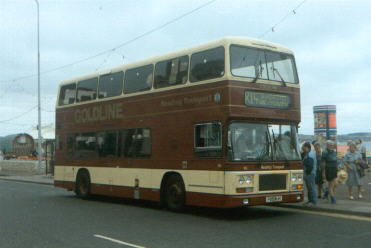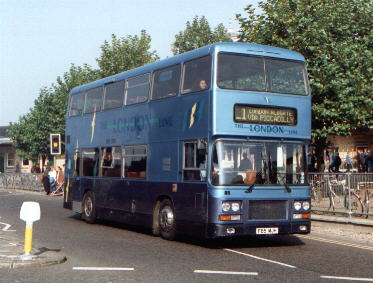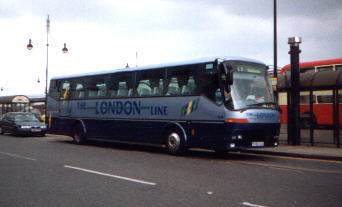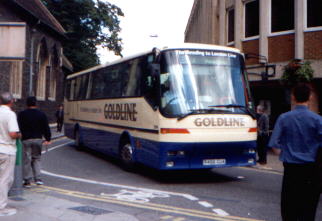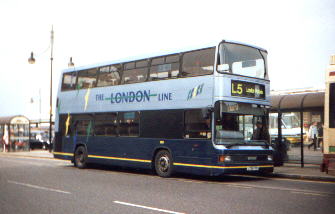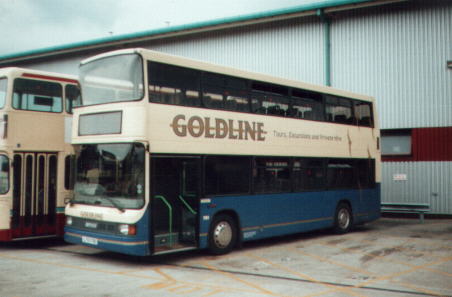Reading Transport - Goldline
www.buszone.co.uk
Inspired by the 1980 Transport Act, new express service X1 was introduced in partnership with Southend Transport between Reading, Heathrow, London and Southend-on-Sea on 6th October 1980, the day the new legislation took effect. Reading used standard maroon and ivory MCW Metrobuses (supplemented by two MCW Metropolitans), and Southend provided provided single deck coaches in their blue and cream livery. It was difficult to keep time on such a long route, however, and each operator wanted to develop the route in its own way, and so in May 1982 the joint arrangement ceased with Southend Transport running Southend-London-Heathrow and Reading Transport Reading-London Aldgate, both as X1.
Reading re-branded its service Goldline X1 and introduced dual-purpose Metrobuses 189-193 in a special maroon and cream livery with gold lettering. They were fitted with slightly more comfortable seating and high-speed differentials, but retained Reading's standard dual door layout so that they could be cascaded to town work after a few years intensive motorway service. The vehicles were also used on weekend express services to places such as Birmingham and Bournemouth, as well as day tours, forming the basis of what became the Goldline Travel coaching business. MCW Metropolitans 120 and 121 had high speed differentials fitted for a trip to Dusseldorf, and 132 and 133 were fitted when new with coach type seating and high speed differentials to facilitate private hire duties.
In 1983 Leyland Titans 75-9 were delivered in Goldline Express livery for the X1 service, and were fitted with high-speed differentials. Reading's first steps into the luxury coach hire market began in March 1983 with the acquisition of four Leyand Tiger / Plaxton Paramount 3200 coaches. The justification for their purchase was for off-peak use on the Goldline X1, but they were also intended for luxury private hires - an experimental aspect of the company's activities which grew and grew, and it was not long until these vehicles were used more for private hire than express work. In 1985 the Titans received an updated Goldline livery which omitted any mention of London to allow use of both types of work. By then, in addition to Private Hire, Goldline buses and coaches operated express services such as the X62 to Brighton and Eastboune, excursions and day trips, and extended tours and holidays in the UK and on the continent.
In 1984 MCW Metrobus Mk2s 143-9 were delivered, featuring luxury coach interiors and turbocharged engines. Their Goldline livery was revised with London Express omitted, making them suitable for any service. They were eventually repainted into town livery apart from 143 which in 1992 received a new Goldline red livery for private hire work, and was named Poppy.
Leyland Olympians 80-84 arrived in late summer 1986 and were painted in Goldline epxress livery, but without the Reading crest, the first buses not to have this. When 85-7 arrived in 1988 the Goldline Titans were cascaded to local bus work, retaining Goldline livery for a while, operating town services, and the occasional X1 appearance.
85 seen here in Weymouth on excursion X14. This photograph was originally from the W. Ball collection.
In April 1991 Reading Transport acquired the competing Reading-based Londonlink operations from The Bee Line , together with eight Hestair-Duple 425 coaches. The Goldline and Londonlink services continued to operate separately until April 1992, when they were replaced by an integrated service rebranded The London Line. Londonlink services had operated out of Reading via two or three different routes, and had used Victoria as their London terminus. The opportunity was taken to combine the best features of both operations, resulting in a network of routes operating between various points in the Reading area, and using both Aldgate and Victoria as terminal points. The Londonlink X1/X2 and Reading X1 were combined to give the London Line L1, with other numbers used for the other routes. The Olympians and ex-BeeLine coaches were painted in a new three-tone metallic blue livery, the name of the service was not announced until just before the launch, so for about a month the vehicles ran without lettering. Goldline Metrobuses made a brief return to front line service whilst they were repainted.
85 in 1992 in The London Line livery. This photograph was originally from the W. Ball collection.
When Reading Transport acquired The Bee Line's Reading and Newbury bus operations in August 1992, the Newbury Londonlink operations were included. These continued to run independently for a few months, but from October 1992 they were integrated into The London Line network. Three Volvo B10M coaches and a Leyland Tiger were included with these, but the Tiger was soon withdrawn.
A fifth new coach, Scania / VanHool was added in April 1989. Three of the four Leyland Tigers were withdrawn in early 1991, with 201 lasting until early 1992. The Goldline name was retained for an expanded luxury coaching market using red liveried coaches - a tribute to the success of this pioneering quartet. The style of Goldline lettering was modernised in early 1994.
Following the launch of The London Line some quality used coaches were acquired to supplement the fleet, and in early 1994 two new Optare Spectra coaches were acquired allowing Olympians 80/81 to be withdrawn. In 1995 two new Bova Futura coaches were purchased to assess customer support for the type whilst the rest of the London service was operated by Optare Spectras 751/2, Plaxton Paramounts 261/2 and a mixture of VanHool Alizees and Jonckheere Jubilees. Two Bova demonstrators were added in 1997 and 1999.
Here 274 is at Reading Station in the two-tone London Line livery in May 1998.
At its height in the 1980s, the X1 had over 20 vehicles, with passenger volumes boosted by rail strikes and low fares. Eventually after a gradual thinning of the timetable, not helped by improved rail frequencies, significantly increased traffic congestion and staff shortages, one last ditch attempt was made to secure the future of the service in July/August 1999 by re-branding it as "Goldline - The Reading to London Line" with a new cream based livery with blue skirt and updated Goldline logo. The same livery was applied to the private hire fleet without the London lettering for the first time since 1993.
Here is 274 emerging from Blagrave Street in August 1999 freshly after re-paint into "Goldline The Reading to London Line".
Optare Spectra 751 seen departing Reading station on the L5 in March 1998.
In May 2000 the London services were withdrawn, with the most modern vehicles (Spectras 751/2 and Bovas 271-4) transferring to the private hire fleet to allow non-standard vehicles to depart. 751/2 were subsequently withdrawn in 2002.
Here is 751 in the Reading Buses depot in Goldline livery, after losing it's London Line branding in favour of private hire branding. It is seen here in June 2000.
Two T9 Alizée coaches joined the fleet in April 2001, numbered 241-2. Their primary role was to operate a special night time coach link to Gatwick Airport in connection with Thames Trains. They wore standard Goldline livery with Thames Trains logos, and were withdrawn in April 2004 upon expiry of the contract.
The first two of six Scania / Irizar Centurys arrived in November 2003, introducing a new green goGOLDLINE.com livery for the fleet, followed by four in March/April 2004. These replaced all of the remaining private hire fleet with a single vehicle type.
Ultimately, in in August 2008 a decision was made to finish the Goldline coach operations, leading to the disposal of the coaches at the end of their leases. Private hire bookings were gradually transferred to Stewarts of Mortimer between October 2008 and February 2009, with four coaches temporarily going on loan there to assist with the transfer. The tours and excursions programme was sold to Truemans Coach Hire in August 2008.
Goldline did however continue as an internal bus contracts division, including contracted services like the Loddon Bridge Park & Ride, DayTrack and Thames Valley Park. Goldline logos appeared on buses branded for those routes for a period of time as well. Reading Buses started the contract for route 142 between Reading, Pangbourne and Checkendon on 2nd June 2008, and painted Optare Solo 122 painted in two-tone green Goldline livery which lasted until March 2012, and became the last Goldline branded vehicle in the fleet.
By 2012, contract changes and new vehicle deliveries mean that all operations had been integrated under the single Reading Buses brand.
